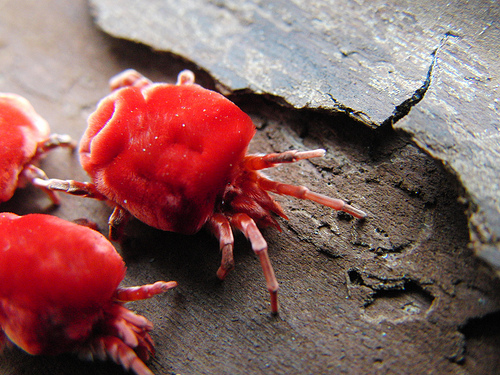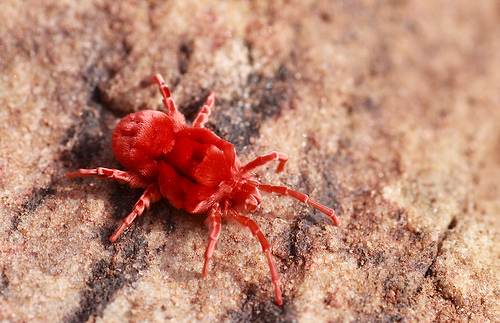Trombidium grandissimum "Giant Red Velvet Mite"
Interactions
During the larva stage, T. grandissimum
is a parasite. They have
 a broad range of hosts ranging
from flies to spiders to moths, and in India the most common
hosts are crickets. The larva sucks fluid through the
feeding tube it inserts into the host for nutrients. They also
utilize the host for dispersal methods. While the affects vary,
overall survival and reproduction is affected by the Red
Velvet Mites, but like most smart parasites rarely do they kill
the host. Not only
does the larva stage parasitize insects, but they are also known
to parasitize adult forms of Giant Red Velvet Mites! As adults, T. grandissimum are predatory.
They actively feed on termites, aphids, spider mites, and beetle mites. They are also known to partake in cannibalism and
feast on each other!
a broad range of hosts ranging
from flies to spiders to moths, and in India the most common
hosts are crickets. The larva sucks fluid through the
feeding tube it inserts into the host for nutrients. They also
utilize the host for dispersal methods. While the affects vary,
overall survival and reproduction is affected by the Red
Velvet Mites, but like most smart parasites rarely do they kill
the host. Not only
does the larva stage parasitize insects, but they are also known
to parasitize adult forms of Giant Red Velvet Mites! As adults, T. grandissimum are predatory.
They actively feed on termites, aphids, spider mites, and beetle mites. They are also known to partake in cannibalism and
feast on each other!
Now, how can a little mite affect someone as big and powerful as a human? The oil secretions of the mite have been used for centuries in traditional Indian medicine to cure a number of different ailments. When the mites emerge for the short time during the rainy season, children and adults gather them up to sell. Some of the ailments the magical oil is though to cure are immunity related diseases, such as paralysis. Healers also use the oil to increase sexual desire, giving the Giant Red Velvet Mite another name, "Indian Viagra."
Research is now being co nducted to test the validity
of the secreted oil, and so far, the results appear promising.
Research conducted using Swiss Albino Mice shows the mice injected with
oil extracts had a higher immune response compared to the control mice
and mice injected with regular saline. With 80% of people in the
world relying on animal and plant based medicine, this little mite may
be of huge importance down the road. Another study was just
recently conducted to test the oil to determine how antifungal it may
be. Oil secreted from the skin, whole body and hemolymph were
inoculated onto agar plates containing known human fungal pathogens.
All three fluids exhibited a ring of clear zone, but the hemolymph had
the largest ring. This means the secretions and fluid of T.
grandissimum contain antifungal compounds and could be utilized in
the future as medication. Continue to facts to learn more about
T. grandissimum.
nducted to test the validity
of the secreted oil, and so far, the results appear promising.
Research conducted using Swiss Albino Mice shows the mice injected with
oil extracts had a higher immune response compared to the control mice
and mice injected with regular saline. With 80% of people in the
world relying on animal and plant based medicine, this little mite may
be of huge importance down the road. Another study was just
recently conducted to test the oil to determine how antifungal it may
be. Oil secreted from the skin, whole body and hemolymph were
inoculated onto agar plates containing known human fungal pathogens.
All three fluids exhibited a ring of clear zone, but the hemolymph had
the largest ring. This means the secretions and fluid of T.
grandissimum contain antifungal compounds and could be utilized in
the future as medication. Continue to facts to learn more about
T. grandissimum.
Back to main page.